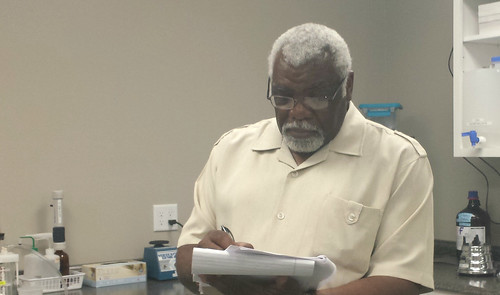
July is the height of summer grilling season, and throughout the month USDA is highlighting changes made to the U.S. food safety system over the course of this Administration. For an interactive look at USDA’s work to ensure your food is safe, visit the USDA Results project on Medium.com and read Chapter Seven: Safer Food and Greater Consumer Confidence.
From soup to nuts, we use science to help ensure the quality of agricultural products for consumers worldwide. As a Microbiologist for USDA’s Agricultural Marketing Service (AMS), I am one of a small group of highly-qualified auditors that travel across the country to certify over 70 private laboratories. These labs are consistently testing to verify the quality and wholesomeness of U.S. food and agricultural products.
Our Laboratory Approval Service approves, or accredits, labs that test agricultural products in support of domestic and international trade. Our programs cover a variety of products from aflatoxin testing in peanuts and tree nuts to export verification for meat and poultry products.
Part of my job is to travel to lab to perform audits of the labs that test for aflatoxin in almonds, peanuts, and pistachio nuts. Aflatoxins are toxic metabolites produced by the molds Aspergillus flavus, Aspergillus nomius, and Aspergillus parasiticus. If present in sufficient amounts, aflatoxins are known to be carcinogenic and may cause acute toxicity, a food safety issue for both humans and animals. Fortunately there has never been a case of aflatoxicosis in the United States.
My on-site audits ensure the laboratories performing aflatoxin analysis have proper training, good laboratory practices, quality assurance procedures, domestic and international standards, established methods and required equipment. I travel to very rural parts of the country to visit labs which voluntarily participate in the accreditation program for a set fee. Often packing a lunch is essential as I can spend a full day at a processing facility in the middle of an almond orchard with the nearest town miles away.
A fascinating part of my job is learning the wide and varied uses for the products that are being tested. Did you know that peanuts are used in sauces, gravy and soup mixes as well as snack foods? It is also amazing what I find outside the labs, like when I had to drive past acre after acre of cattle of large cattle ranches and big game ranches in Texas to reach a peanut laboratory to review their facilities. It was just one laboratory that served peanut growers and shellers in West Texas and New Mexico!
Or after a long day reviewing a peanut testing facility, I was amazed by what I discovered in down town Albany, GA - a life-size sculpture of Ray Charles in the center of the Plaza along the Flint River. He is seated at a baby Grand piano on a rotating pedestal and at timed intervals, water flows over the pedestal and spills into a reflecting pool at its base. You get the experience of a live concert by Ray as his songs are play through speakers on the Plaza. The sculpture is flanked on either side by a keyboard walkway with sharps and flat keys that serve as benches. But it is the people in these rural places that care, grow, transport and produce our food that make my job special.
Back in the office, my colleagues and I assess our audits, share our experiences and talk about how we are helping farmers and ranchers market their quality products here and around the world. From farm to fork, our approach to marketing relies on science — not only to ensure product safety, quality and wholesomeness for consumers, but also to improve marketing opportunities and production efficiency for American producers.



